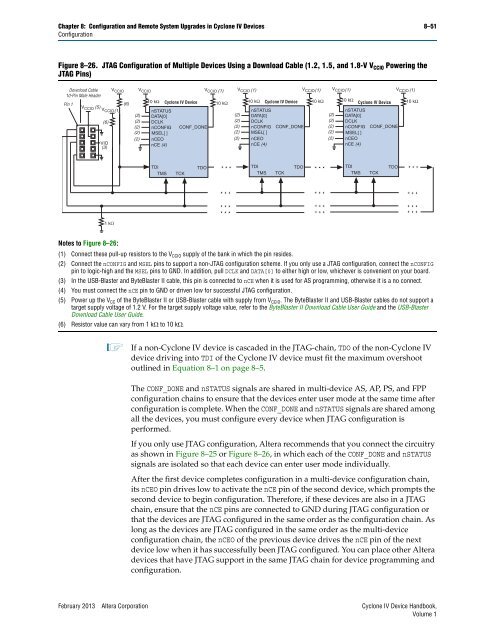Configuration and Remote System Upgrades in Cyclone IV ... - Altera
Configuration and Remote System Upgrades in Cyclone IV ... - Altera
Configuration and Remote System Upgrades in Cyclone IV ... - Altera
Create successful ePaper yourself
Turn your PDF publications into a flip-book with our unique Google optimized e-Paper software.
Chapter 8: <strong>Configuration</strong> <strong>and</strong> <strong>Remote</strong> <strong>System</strong> <strong>Upgrades</strong> <strong>in</strong> <strong>Cyclone</strong> <strong>IV</strong> Devices 8–51<br />
<strong>Configuration</strong><br />
Figure 8–26. JTAG <strong>Configuration</strong> of Multiple Devices Us<strong>in</strong>g a Download Cable (1.2, 1.5, <strong>and</strong> 1.8-V V CCIO Power<strong>in</strong>g the<br />
JTAG P<strong>in</strong>s)<br />
Download Cable VCCIO VCCIO VCCIO (1) VCCIO (1)<br />
VCCIO(1) VCCIO(1) VCCIO (1)<br />
10-P<strong>in</strong> Male Header<br />
P<strong>in</strong> 1<br />
VCCIO (5)<br />
VCCIO(1) (6)<br />
(6)<br />
(2)<br />
(2)<br />
(2)<br />
(2)<br />
10 kΩ <strong>Cyclone</strong> <strong>IV</strong> Device<br />
nSTATUS<br />
DATA[0]<br />
DCLK<br />
nCONFIG CONF_DONE<br />
MSEL[ ]<br />
10 kΩ<br />
(2)<br />
(2)<br />
(2)<br />
(2)<br />
10 kΩ <strong>Cyclone</strong> <strong>IV</strong> Device<br />
nSTATUS<br />
DATA[0]<br />
DCLK<br />
nCONFIG CONF_DONE<br />
MSEL[ ]<br />
10 kΩ<br />
(2)<br />
(2)<br />
(2)<br />
(2)<br />
10 kΩ<br />
<strong>Cyclone</strong> <strong>IV</strong> Device<br />
nSTATUS<br />
DATA[0]<br />
DCLK<br />
nCONFIG CONF_DONE<br />
MSEL[ ]<br />
10 kΩ<br />
VIO<br />
(3)<br />
(2) nCEO<br />
nCE (4)<br />
(2) nCEO<br />
nCE (4)<br />
(2) nCEO<br />
nCE (4)<br />
1 kΩ<br />
Notes to Figure 8–26:<br />
TDI TDO<br />
TMS TCK<br />
TDI TDO<br />
TMS TCK<br />
TDI TDO<br />
TMS TCK<br />
(1) Connect these pull-up resistors to the VCCIO supply of the bank <strong>in</strong> which the p<strong>in</strong> resides.<br />
(2) Connect the nCONFIG <strong>and</strong> MSEL p<strong>in</strong>s to support a non-JTAG configuration scheme. If you only use a JTAG configuration, connect the nCONFIG<br />
p<strong>in</strong> to logic-high <strong>and</strong> the MSEL p<strong>in</strong>s to GND. In addition, pull DCLK <strong>and</strong> DATA[0] to either high or low, whichever is convenient on your board.<br />
(3) In the USB-Blaster <strong>and</strong> ByteBlaster II cable, this p<strong>in</strong> is connected to nCE when it is used for AS programm<strong>in</strong>g, otherwise it is a no connect.<br />
(4) You must connect the nCE p<strong>in</strong> to GND or driven low for successful JTAG configuration.<br />
(5) Power up the VCC of the ByteBlaster II or USB-Blaster cable with supply from VCCIO. The ByteBlaster II <strong>and</strong> USB-Blaster cables do not support a<br />
target supply voltage of 1.2 V. For the target supply voltage value, refer to the ByteBlaster II Download Cable User Guide <strong>and</strong> the USB-Blaster<br />
Download Cable User Guide.<br />
(6) Resistor value can vary from 1 k to 10 k.<br />
1 If a non-<strong>Cyclone</strong> <strong>IV</strong> device is cascaded <strong>in</strong> the JTAG-cha<strong>in</strong>, TDO of the non-<strong>Cyclone</strong> <strong>IV</strong><br />
device driv<strong>in</strong>g <strong>in</strong>to TDI of the <strong>Cyclone</strong> <strong>IV</strong> device must fit the maximum overshoot<br />
outl<strong>in</strong>ed <strong>in</strong> Equation 8–1 on page 8–5.<br />
The CONF_DONE <strong>and</strong> nSTATUS signals are shared <strong>in</strong> multi-device AS, AP, PS, <strong>and</strong> FPP<br />
configuration cha<strong>in</strong>s to ensure that the devices enter user mode at the same time after<br />
configuration is complete. When the CONF_DONE <strong>and</strong> nSTATUS signals are shared among<br />
all the devices, you must configure every device when JTAG configuration is<br />
performed.<br />
If you only use JTAG configuration, <strong>Altera</strong> recommends that you connect the circuitry<br />
as shown <strong>in</strong> Figure 8–25 or Figure 8–26, <strong>in</strong> which each of the CONF_DONE <strong>and</strong> nSTATUS<br />
signals are isolated so that each device can enter user mode <strong>in</strong>dividually.<br />
After the first device completes configuration <strong>in</strong> a multi-device configuration cha<strong>in</strong>,<br />
its nCEO p<strong>in</strong> drives low to activate the nCE p<strong>in</strong> of the second device, which prompts the<br />
second device to beg<strong>in</strong> configuration. Therefore, if these devices are also <strong>in</strong> a JTAG<br />
cha<strong>in</strong>, ensure that the nCE p<strong>in</strong>s are connected to GND dur<strong>in</strong>g JTAG configuration or<br />
that the devices are JTAG configured <strong>in</strong> the same order as the configuration cha<strong>in</strong>. As<br />
long as the devices are JTAG configured <strong>in</strong> the same order as the multi-device<br />
configuration cha<strong>in</strong>, the nCEO of the previous device drives the nCE p<strong>in</strong> of the next<br />
device low when it has successfully been JTAG configured. You can place other <strong>Altera</strong><br />
devices that have JTAG support <strong>in</strong> the same JTAG cha<strong>in</strong> for device programm<strong>in</strong>g <strong>and</strong><br />
configuration.<br />
February 2013 <strong>Altera</strong> Corporation <strong>Cyclone</strong> <strong>IV</strong> Device H<strong>and</strong>book,<br />
Volume 1
















